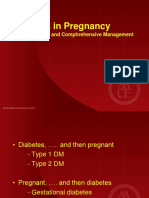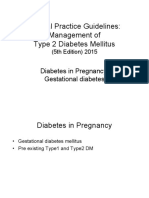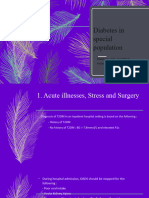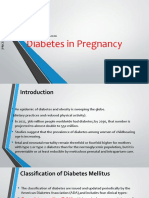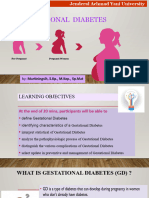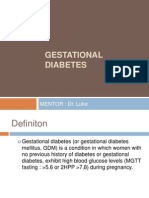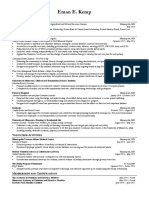Managing Gestational Diabetes Mellitus (GDM) in the Community Pharmacy Setting
Introduction
Definition: Briefly define gestational diabetes mellitus (GDM) as glucose intolerance that first occurs or is
first recognized during pregnancy.
Prevalence: Mention that GDM affects about 6-9% of pregnancies, making it a common concern in
community pharmacy practice. (CDC 2016-2020)
Importance: Discuss the importance of managing GDM to prevent complications such as macrosomia,
preeclampsia, and type 2 diabetes later in life for both mother and child.
Pathophysiology
Explain the underlying mechanisms of GDM, including insulin resistance and the role of placental
hormones.
The underlying mechanisms of Gestational Diabetes Mellitus (GDM) primarily involve insulin resistance driven by
hormonal changes during pregnancy. Here’s a breakdown of these mechanisms:
Discuss how GDM develops typically in the second or third trimester as insulin requirements increase.
Screening and Diagnosis
Outline the common screening methods, including the glucose challenge test (GCT) and oral glucose
tolerance test (OGTT).
Diagnostic Criteria: GDM is diagnosed if one or more of the blood glucose values exceed the set
thresholds.
o For a 75-gram OGTT (2-hour test): The thresholds are typically fasting ≥92 mg/dL, 1-hour ≥180
mg/dL, and 2-hour ≥153 mg/dL.
o For a 100-gram OGTT (3-hour test): Common thresholds are fasting ≥95 mg/dL, 1-hour ≥180
mg/dL, 2-hour ≥155 mg/dL, and 3-hour ≥140 mg/dL.
Summary of Screening Process:
Step 1: Most pregnant women undergo the Glucose Challenge Test (GCT) around 24-28 weeks of
pregnancy.
Step 2: If the GCT result is abnormal, the patient is typically referred for an Oral Glucose Tolerance Test
(OGTT) to confirm the diagnosis of GDM.
Management Strategies
1. Lifestyle Modifications:
� o Emphasize the role of diet and exercise in managing GDM.
o Discuss specific dietary recommendations, including carbohydrate counting and portion control.
o Highlight the importance of regular physical activity to improve insulin sensitivity.
2. Pharmacologic Treatment
ACOG recommends that insulin be the preferred therapy if glycemic control is not obtained with
nonpharmacologic treatment
Substantial number of patients started on oral therapy will require insulin during pregnancy
o Starting insulin dose 0.7 to 1.0 units/kg daily
o Dosage should be divided and long-acting or intermediate-acting insulin in combination with
short-acting insulin should be used
o Individualize based on patients glycemic pattern
o Short acting analogues (e.g. insulin lispro and aspart) preferred over regular insulin due to more
rapid onset
o NPH insulin still used for but insulin glargine and detemir available for long-acting coverage
If a patient cannot take insulin or declines, metformin can be used
o Counsel about metformin risks including placental cross over and no long term studies in
offspring available
May be associated with preterm birth
o Starting dose: 500 mg nightly for 1 week, increase to 500 twice daily
Check baseline creatinine
o Adverse events include abdominal pain and diarrhea – recommend with meals
o Maximal dose is 2,500 to 3,000 mg per day, in two or three divided doses
Glyburide should not be used in place of insulin as studies show worse outcome, including macrosomia
and birth injury
o Starting dose is 2.5 to 20 mg per day in divided doses
o Up to 30 mg may be necessary to obtain glycemic control
o Long term outcome studies also still lacking, although no short term adverse events have been
noted
� 3. Monitoring:
o Discuss the importance of self-monitoring of blood glucose (SMBG) and how to counsel patients
on proper techniques.
o Review target blood glucose levels for patients with GDM (e.g., fasting <95 mg/dL, 1-hour
postprandial <140 mg/dL, 2-hour postprandial <120 mg/dL).
Role of the Community Pharmacist
Patient Education: Highlight the pharmacist’s role in educating patients about GDM management,
including medication use, dietary modifications, and the importance of regular monitoring.
Medication Adherence: Discuss strategies to improve adherence, such as setting reminders, simplifying
regimens, and addressing barriers to insulin use.
Collaborative Care: Emphasize the importance of working with other healthcare providers, such as
OB/GYNs and dietitians, to optimize patient outcomes.
Postpartum Care: Discuss the need for follow-up after delivery to monitor for type 2 diabetes and the
pharmacist’s role in providing this continuity of care.






